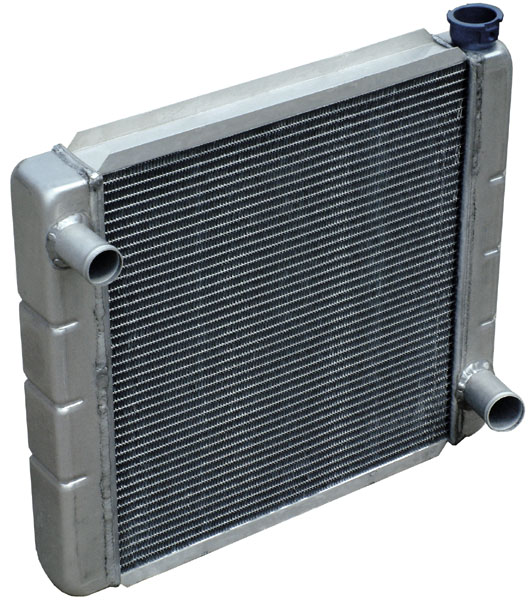|
Heat Cost Allocator
Heat cost allocators are devices attached to individual radiators in buildings that measure the total heat output of the individual radiator. Heat cost allocators can be either electronic, where one or two electronic thermosensors and a microcontroller are used to calculate the heat consumption of radiator by the temperature difference between the radiator and the air in room, or evaporative, where a special, calibrated liquid in a capillary tube records the total heat absorbed from the air (for which an average allowance is made) in addition to that output by the radiator. Tubes filled with methyl benzoate according to DIN EN 835 can be used by checking the color change. Working principle As the radiator heats up, the back section also heats up. The temperature (or the temperature difference to room temperature for electronic two-sensor devices) is integrated over the heating period (one year according to the heating costs ordinance) and thus forms the measured value. Since the ... [...More Info...] [...Related Items...] OR: [Wikipedia] [Google] [Baidu] |
Radiator
A radiator is a heat exchanger used to transfer thermal energy from one medium to another for the purpose of cooling and heating. The majority of radiators are constructed to function in cars, buildings, and electronics. A radiator is always a source of heat to its environment, although this may be for either the purpose of #Heating, heating an environment, or for cooling the fluid or coolant supplied to it, as for automotive #Engine cooling, engine cooling and Heating, ventilation, and air conditioning, HVAC dry cooling towers. Despite the name, most radiators transfer the bulk of their heat via convection instead of thermal radiation. History The Roman hypocaust is an early example of a type of radiator for building space heating. Franz San Galli, a Prussia, Prussian-born Russian businessman living in St. Petersburg, is credited with inventing the heating radiator around 1855, having received a radiator patent in 1857, but American Joseph Nason and Scot Rory Gregor developed a ... [...More Info...] [...Related Items...] OR: [Wikipedia] [Google] [Baidu] |
Microcontroller
A microcontroller (MC, uC, or μC) or microcontroller unit (MCU) is a small computer on a single integrated circuit. A microcontroller contains one or more CPUs (processor cores) along with memory and programmable input/output peripherals. Program memory in the form of NOR flash, OTP ROM, or ferroelectric RAM is also often included on the chip, as well as a small amount of RAM. Microcontrollers are designed for embedded applications, in contrast to the microprocessors used in personal computers or other general-purpose applications consisting of various discrete chips. In modern terminology, a microcontroller is similar to, but less sophisticated than, a system on a chip (SoC). A SoC may include a microcontroller as one of its components but usually integrates it with advanced peripherals like a graphics processing unit (GPU), a Wi-Fi module, or one or more coprocessors. Microcontrollers are used in automatically controlled products and devices, such as automobile engi ... [...More Info...] [...Related Items...] OR: [Wikipedia] [Google] [Baidu] |
Liquid
Liquid is a state of matter with a definite volume but no fixed shape. Liquids adapt to the shape of their container and are nearly incompressible, maintaining their volume even under pressure. The density of a liquid is usually close to that of a solid, and much higher than that of a gas. Therefore, liquid and solid are classified as condensed matter. Meanwhile, since both liquids and gases can flow, they are categorized as fluids. A liquid is composed of atoms or molecules held together by intermolecular bonds of intermediate strength. These forces allow the particles to move around one another while remaining closely packed. In contrast, solids have particles that are tightly bound by strong intermolecular forces, limiting their movement to small vibrations in fixed positions. Gases, on the other hand, consist of widely spaced, freely moving particles with only weak intermolecular forces. As temperature increases, the molecules in a liquid vibrate more intensely, causi ... [...More Info...] [...Related Items...] OR: [Wikipedia] [Google] [Baidu] |
Methyl Benzoate
Methyl benzoate is an organic compound. It is an ester with the chemical formula , sometimes abbreviated as , where Ph and Me are phenyl and methyl, respectively. Its structure is . It is a colorless liquid that is poorly soluble in water, but miscible with organic solvents. Methyl benzoate has a pleasant smell, strongly reminiscent of the fruit of the feijoa tree, and it is used in perfumery. It also finds use as a solvent and as a pesticide used to attract insects such as orchid bees. Synthesis and reactions Methyl benzoate is formed by the condensation of methanol and benzoic acid, in presence of a strong acid.. Methyl benzoate reacts at both the ring and the ester, depending on the substrate. Electrophiles attack the ring, illustrated by acid-catalysed nitration with nitric acid to give methyl 3-nitrobenzoate. Nucleophiles attack the carbonyl center, illustrated by hydrolysis with addition of aqueous NaOH to give methanol and sodium benzoate. Occurrence Methyl benzo ... [...More Info...] [...Related Items...] OR: [Wikipedia] [Google] [Baidu] |
Heat Transfer
Heat transfer is a discipline of thermal engineering that concerns the generation, use, conversion, and exchange of thermal energy (heat) between physical systems. Heat transfer is classified into various mechanisms, such as thermal conduction, Convection (heat transfer), thermal convection, thermal radiation, and transfer of energy by phase changes. Engineers also consider the transfer of mass of differing chemical species (mass transfer in the form of advection), either cold or hot, to achieve heat transfer. While these mechanisms have distinct characteristics, they often occur simultaneously in the same system. Heat conduction, also called diffusion, is the direct microscopic exchanges of kinetic energy of particles (such as molecules) or quasiparticles (such as lattice waves) through the boundary between two systems. When an object is at a different temperature from another body or its surroundings, heat flows so that the body and the surroundings reach the same temperature, ... [...More Info...] [...Related Items...] OR: [Wikipedia] [Google] [Baidu] |



